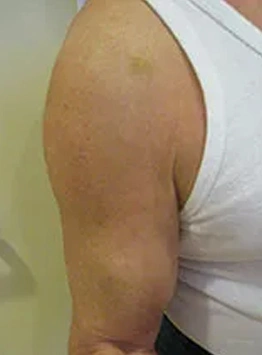Shoulder Center Saar
The long biceps tendon
Conditions such as calcific tendonitis and impingement syndrome are now widely known. In contrast, knowledge of the various disorders of the long biceps tendon is limited. Detailed knowledge of the various pathologies and, above all, the various treatment options is still scarce, even among many physicians.
One reason may be that changes in the long biceps tendon are very difficult to visualize with modern imaging techniques. They cannot be reliably detected in X-rays, ultrasounds, or computed tomography. Even magnetic resonance imaging, which is repeatedly hailed as the ultimate diagnostic tool, cannot reliably diagnose individual disorders.
Diseases of the long biceps tendon are rightly considered to be among the most frequently overlooked diagnoses. It is not for nothing that they are also referred to as "hidden diagnoses." In such cases, it is all the more important for the physician to have extensive experience with these conditions. This is the only way to get on the right track and consider these "hidden" diagnoses. A detailed medical history and special examination techniques can confirm an initial suspicion. Further diagnostic procedures also require a high degree of experience and expertise from the examiner. Dynamic, high-resolution ultrasound examinations can demonstrate instabilities of the long biceps tendon. Furthermore, arthro-MRI, in which a magnetic contrast agent is injected directly into the shoulder, enables improved visualization of the joint space and, above all, the long biceps tendon in magnetic resonance imaging.
The biceps muscle has two tendon origins. The long tendon originates at the superior glenoid rim and the cartilaginous lip located there, the glenoid labrum. The short biceps tendon originates from the coracoid process, also known as the coracoid process. The long biceps tendon runs from the superior glenoid rim across the shoulder joint and over the humeral head.
At the front of the humeral head is a small groove, also called the intertubercular sulcus. At this point, the tendon bends downward by 90° and then runs down the aforementioned canal on the front of the shoulder. Only below the canal does the tendon then merge into the muscle.
Due to its long course within the joint and the sharp bending at the transition into the bicipital groove, the long biceps tendon is subjected to considerable mechanical stress. This often leads to premature wear or, if overloaded, to local inflammation of the tendon. In addition to inflammation, wear-related partial or complete tears play a significant role.
To prevent the healthy tendon from slipping out of the canal of the intertubercular sulcus during various arm movements, it is held in place by a ligament structure that runs circumferentially around the tendon, the so-called pulley system. Wear and tear and injuries can also lead to discomfort here. Pulley lesions, in particular, with resulting instability of the long biceps tendon, often lead to prolonged suffering for patients, as the pathology is easily overlooked.
Pathologies in the origin of the long biceps tendon often lead to involvement of the superior glenoid labrum. These lesions are referred to as SLAP lesions.
Overhead athletes such as javelin throwers, tennis, basketball, or handball players are particularly at risk for injuries to the long biceps tendon and its supporting structure. However, people who frequently perform overhead work, such as painters or plasterers, can also experience premature wear of the pulley system and tendon. Such changes manifest themselves as loss of strength and pain.

When exposed to significant force, it's not uncommon for a previously damaged long biceps tendon to suddenly rupture. As the tendon then slips down, the muscle in the upper arm contracts. This causes the muscle belly to become prominent. This phenomenon is also known as the Popeye sign. This situation is usually only visually problematic at first. Over time, the visible swelling diminishes. A noticeable loss of strength usually doesn't occur, so treatment for an acute long biceps tendon rupture consists of a wait-and-see approach.
Injuries to the pulley, its insertion, and inflammation in the area of the long biceps tendon often manifest as pain in the anterior upper arm. These symptoms are often very persistent, so the pain usually persists despite all treatments. Unrecognized lesions of the long biceps tendon are the most common reason for unsuccessful treatment of shoulder pain.
Tragically, such patients are often referred for surgery after unsuccessful treatment. Due to "lack of evidence" or embarrassment, the surgical diagnosis is usually chronic impingement syndrome. In these cases, it is the surgeon's responsibility to make the correct diagnosis during surgery and treat the true pathology during the operation. Otherwise, the failure of such a procedure is unfortunately inevitable.
Once the correct diagnosis of a disorder of the long biceps tendon has been made, attempts can be made to control the symptoms through physiotherapy, tablets, and possibly one or two injections. However, one should not wait longer than three months in total. Structural damage to the tendon or instability occurring as part of pulley lesions are often responsible for the symptoms. Unfortunately, in these cases, conservative treatment is usually unsuccessful, so further waiting is hopeless and often ends in frustration for the patient. For this reason, surgical repair should be considered as early as possible. Particularly if the instability of the long biceps tendon is irritating or even damaging the neighboring subscapularis or supraspinatus tendons, it is high time to establish the indication for surgical treatment. Otherwise, there is a risk of further serious tendon rupture.
The surgical procedure depends on the specific type of injury in each individual case. Detailed information on the various surgical options can be found in the individual subsections Pulley Lesion and SLAP Lesion.



